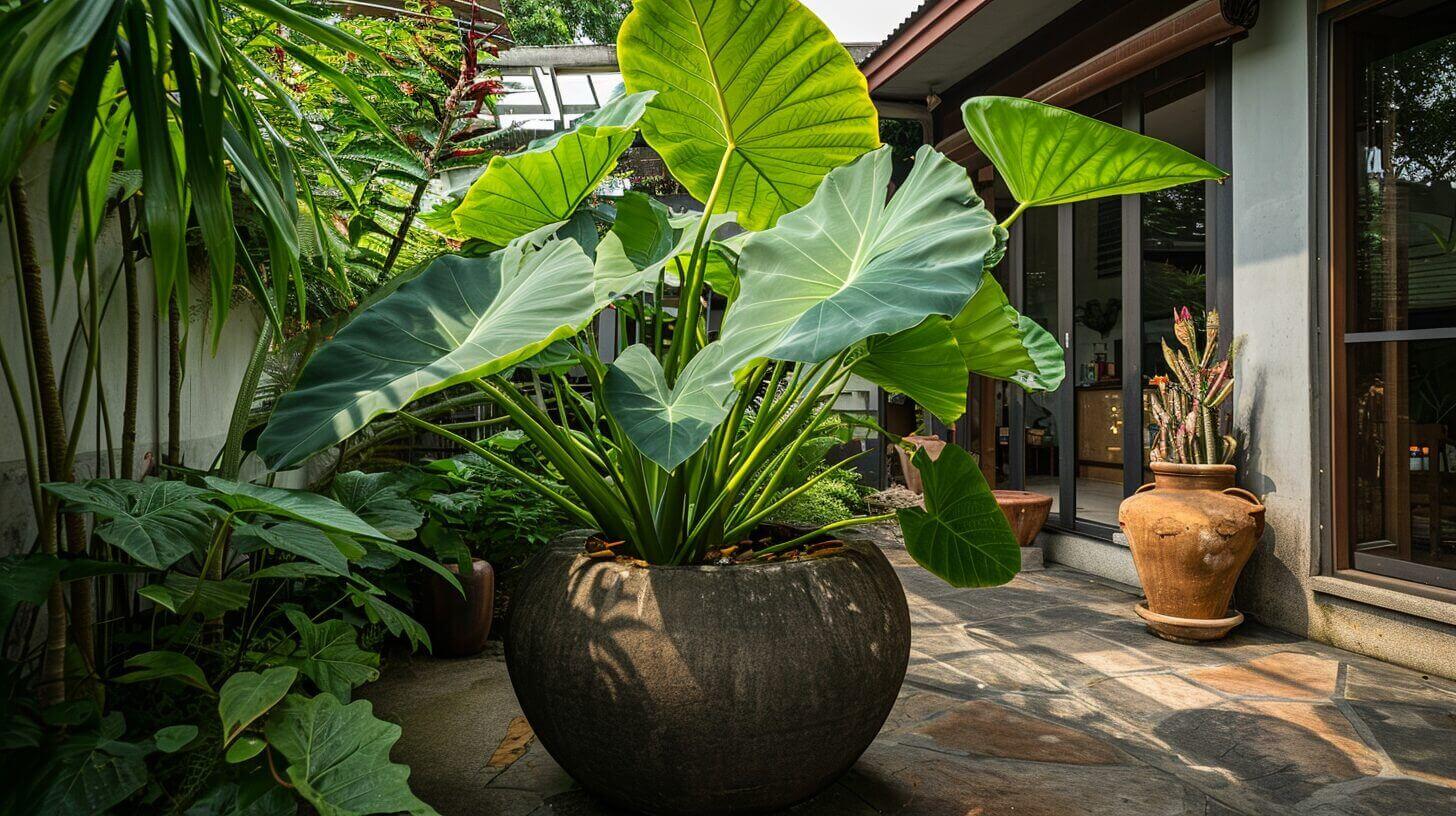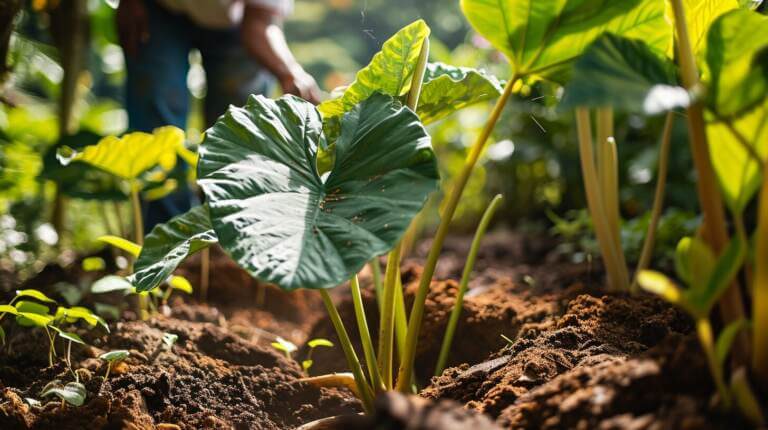Where to Plant Elephant Ear Bulbs for Optimal Growth
Elephant ears are tropical plants with impressive foliage, also known as colocasia and alocasia. They can be grown both indoors and outdoors, and their large heart-shaped leaves add a dramatic touch to any garden or container. To ensure optimal growth, it is important to plant and grow elephant ear bulbs in the right location and provide proper care.
Key Takeaways:
- Choose a location that provides full sun or partial shade for planting elephant ear bulbs.
- Plant the bulbs in rich, well-drained soil when the soil is warm and there is no danger of frost.
- Keep the soil consistently moist throughout the growing season and fertilize regularly.
- In colder climates, dig up the bulbs and store them indoors during the winter months.
- Proper care will help elephant ear bulbs thrive and produce stunning foliage.
Elephant ears can be planted in full sun or partial shade and prefer rich, well-drained soil. The bulbs should be planted when the soil is warm and there is no danger of frost. They should be planted about 1 inch below the soil surface and watered thoroughly. Elephant ears require consistent moisture throughout the growing season and benefit from regular fertilization.
In colder climates, the bulbs should be dug up and stored indoors during the winter months. This is to protect them from freezing temperatures. When storing the bulbs, it is important to clean them and allow them to dry before placing them in a cool, dark place. During the dormant period, it is important to check the bulbs for any signs of rot or damage.
Overall, choosing the right location and providing proper care will help elephant ear bulbs thrive and produce stunning foliage. Whether planted in the ground or in large containers, these tropical plants can add a touch of beauty to any garden or outdoor space.
When and Where to Plant Elephant Ear Bulbs
Planting elephant ear bulbs at the right time and in the right location is crucial for their optimal growth. Here are some important factors to consider:
Soil Temperature
Elephant ear bulbs should be planted when the soil has warmed up to a temperature of at least 65°F. This ensures that the bulbs have the ideal conditions for germination and root development.
Timing
In warmer climates (zones 9-11), where elephant ears can be grown outdoors year-round, it is best to plant the bulbs after all danger of frost has passed. In cooler areas (zones 3-8), it is recommended to plant the bulbs in the spring once the soil has warmed up.
If you live in a colder climate and want to get a head start, you can start the bulbs indoors about 4 to 6 weeks before the last frost date. Once the danger of frost has passed, you can transplant them outside.
Light Requirements
When choosing a location for planting elephant ear bulbs, it is important to consider the amount of sunlight and shade they require. While some dark-leaf varieties can tolerate full sun, grow elephant ears in partial shade or filtered sunlight to prevent leaf scorching.
Soil Quality
Elephant ear bulbs thrive in rich, well-drained soil such as peat moss. It is recommended to amend the soil with compost or organic matter to improve its fertility and drainage. Avoid planting in heavy clay soils that retain too much moisture, as this can lead to rot and other issues.
Containers
If you don’t have a suitable planting location in your garden, elephant ear bulbs can also be grown in containers. Make sure the container has drainage holes to prevent waterlogging, and use a well-draining potting mix blended with compost. Place the container in a location that provides the right amount of sunlight and shade.
| Aspect | Condition |
|---|---|
| Soil Temperature | At least 65°F |
| Timing | After frost has passed (zones 9-11) In spring (zones 3-8) |
| Light Requirements | Partial shade or filtered sunlight |
| Soil Quality | Rich, well-drained soil with organic matter |
| Containers | Well-draining potting mix in a container with drainage holes |
By planting elephant ear bulbs at the right time and in the right location, you can ensure that they have the best conditions to thrive and produce stunning foliage.
How to Care for Elephant Ear Bulbs
Taking care of elephant ear bulbs is crucial to ensure their health and help them reach their full potential. One important aspect of care is providing an adequate water supply. Elephant ears require consistent moisture, so it is important to water them regularly. This will help keep the soil consistently moist, which is essential for their growth and development.
In addition to watering, mulching is another important care practice for elephant ear bulbs. Applying a layer of mulch around the plants can help retain moisture in the soil and also provide insulation during colder months. This is particularly beneficial in regions where freezing temperatures occur, as mulch can help protect the bulbs from frost damage.
During the winter, when freezing temperatures become a concern, overwintering elephant ear bulbs is necessary. To do this, dig up the bulbs in the fall, before temperatures drop below 40°F. Carefully remove the foliage and clean the tubers. It’s important to handle the bulbs with care and avoid any damage. Store the bulbs in a cool, dark place in moist coconut coir or potting soil until the spring. This dormant period will allow the bulbs to rest and prepare for the next growing season.
When spring arrives, it’s time to replant the elephant ear bulbs. However, it’s important to wait until the soil temperature has warmed up before doing so. Plant the tubers at a depth of about 1 inch below the soil surface, with the pointy side facing up. Regular trimming of faded or brown leaves can also encourage new growth and keep the plant looking its best.
FAQ
Where is the best place to plant elephant ear bulbs?
Elephant ear bulbs can be planted in full sun or partial shade. They prefer rich, well-drained soil.
When should I plant elephant ear bulbs?
Elephant ear bulbs should be planted when the soil has warmed up to a temperature of at least 65ºF. In cooler areas, they should be planted in the spring.
How deep should I plant elephant ear bulbs?
Dig a hole about 4 to 6 inches deep and set the tuber with the pointy side up, about 1 inch of soil below the surface.
How often should I water elephant ear bulbs?
Elephant ear bulbs require consistent moisture throughout the growing season. Keep the soil moist and water regularly.
How do I overwinter elephant ear bulbs?
In colder climates, dig up the bulbs in the fall before temperatures drop below 40°F. Allow them to dry, remove the foliage, and store them indoors in a cool, dark place.
How do I care for elephant ear bulbs in containers?
Use a potting mix blended with compost and ensure good drainage. Water regularly and fertilize every 2-3 weeks for optimal growth.
How do I trim elephant ear bulbs?
Regularly trim faded or brown leaves to encourage new growth.
Are elephant ear bulbs perennial?
Elephant ear bulbs are not perennial in all areas. In colder climates, they should be dug up and stored indoors during the winter months.
Do elephant ear bulbs multiply?
Yes, elephant ear bulbs can multiply and produce additional plants over time.
Can I plant elephant ear bulbs indoors?
Yes, elephant ear bulbs can be planted indoors in containers. Ensure proper drainage and provide consistent moisture.







